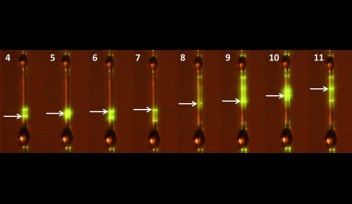Creating Complex Nanoparticles in One Easy Step

Nanoparticle research is huge. That is, the study of nanoparticles, very miniscule objects that act as a unit with specific properties, is a very popular area of study. With implications in many avenues of science, from biomedicine to laser research, the study of how to create nanoparticles with desirable properties is becoming increasingly important. Maria Benelmekki and researchers in Mukhles Sowwan’s Nanoparticles by Design Unit recently made a breakthrough in synthesizing biomedically relevant nanoparticles. They published their findings in the journal Nanoscale.
Nanoparticles can be used in medicine for imaging during diagnosis and treatment. Other applications include targeted drug delivery and wound healing. However, creating nanoparticles for use in biomedicine presents many challenges. Currently, nanoparticles are primarily made using chemicals, which is a problem when using them for medical purposes because these chemicals may be harmful to the patient. Additional issues are that the fabrication process takes several steps, the size of the particles is difficult to control and the particles can only survive in storage for a relatively short amount of time. Benelmekki and colleagues have created biocompatible ternary nanoparticles, meaning they consist of 3 parts that each exhibit a useful property, and have done it without the use of chemicals. The new method allows for easy manipulation of the size of the particles to tailor-make them for a variety of uses all in one step. The researchers have also developed a method that provides better stability for longer storage.
The nanoparticles in the study are made of a core of iron and silver. These two elements imbue them with two important properties; they are magnetic and can be imaged. The iron makes them magnetic, allowing researchers to move them around. The silver is excellent for imaging because excitation of silver creates a larger detection signal than the particle itself, meaning it can be viewed with conventional microscopy or medical imaging devices despite its tiny size. The third part of the nanoparticles is a silicon shell, which surrounds the iron-silver core. The silicon is biocompatible, meaning it can go into a patient without creating complications, it prevents the core from being broken down and it can be easily manipulated for use in a variety of biomedical applications. Additionally, the nanoparticles also have superparamagnetic behavior, meaning they are only magnetic when a magnetic field is applied, so their magnetic property is inducible.
The ability to easily create stable, customizably sized nanoparticles with multiple functionalities, without the use of chemicals, in one step, is an exciting breakthrough. All of this work was possible because of the extensive expertise of the members of the unit in materials science, and their skills to work in a multidisciplinary environment. The implications of the work are potentially vast. Benelmekki says, “The ternary nanoparticles can be used in different applications, such as a contrast agent in MRI, biomagnetic sensors, hyperthermia for cancer treatment and magnetically targeted delivery and transfection.” Maybe the next time you go in for medical imaging or treatment, nanoparticles designed here at OIST will be part of the treatment.
You can read the paper in Nanoscale here:
http://pubs.rsc.org/en/content/articlelanding/2014/nr/c3nr06114k#!divAbstract
By: Kathleen Estes
Specialty
For press enquiries:
Press Inquiry Form
















